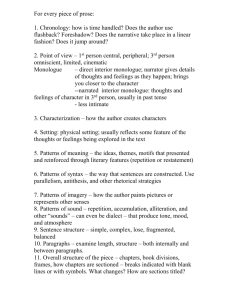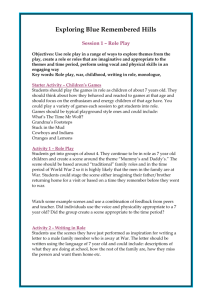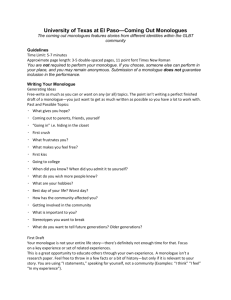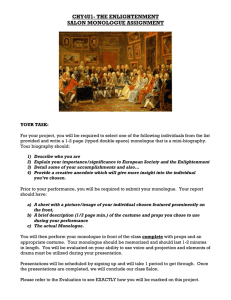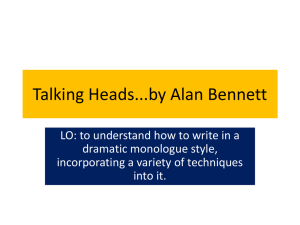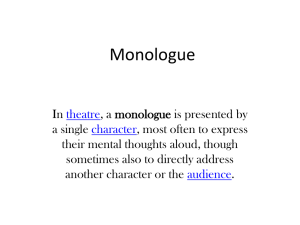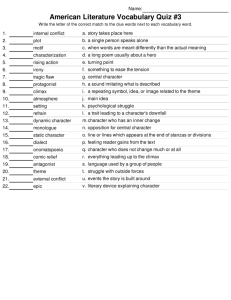The Monologue Challenge Directing the Monologue Directing the
advertisement
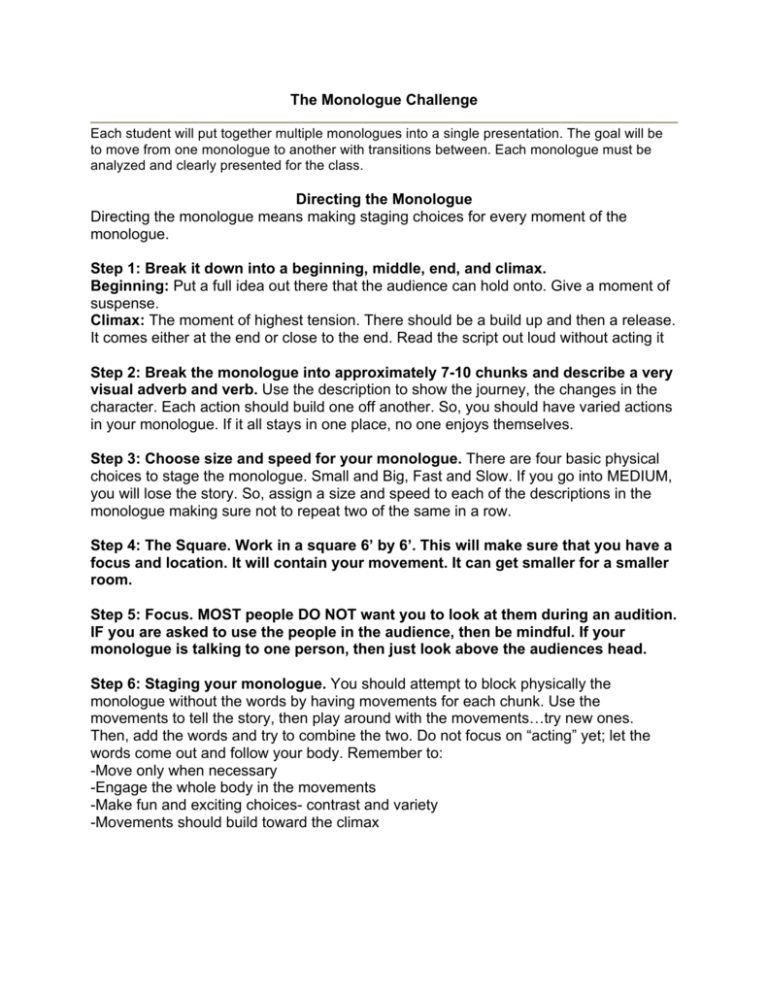
The Monologue Challenge Each student will put together multiple monologues into a single presentation. The goal will be to move from one monologue to another with transitions between. Each monologue must be analyzed and clearly presented for the class. Directing the Monologue Directing the monologue means making staging choices for every moment of the monologue. Step 1: Break it down into a beginning, middle, end, and climax. Beginning: Put a full idea out there that the audience can hold onto. Give a moment of suspense. Climax: The moment of highest tension. There should be a build up and then a release. It comes either at the end or close to the end. Read the script out loud without acting it Step 2: Break the monologue into approximately 7-10 chunks and describe a very visual adverb and verb. Use the description to show the journey, the changes in the character. Each action should build one off another. So, you should have varied actions in your monologue. If it all stays in one place, no one enjoys themselves. Step 3: Choose size and speed for your monologue. There are four basic physical choices to stage the monologue. Small and Big, Fast and Slow. If you go into MEDIUM, you will lose the story. So, assign a size and speed to each of the descriptions in the monologue making sure not to repeat two of the same in a row. Step 4: The Square. Work in a square 6’ by 6’. This will make sure that you have a focus and location. It will contain your movement. It can get smaller for a smaller room. Step 5: Focus. MOST people DO NOT want you to look at them during an audition. IF you are asked to use the people in the audience, then be mindful. If your monologue is talking to one person, then just look above the audiences head. Step 6: Staging your monologue. You should attempt to block physically the monologue without the words by having movements for each chunk. Use the movements to tell the story, then play around with the movements…try new ones. Then, add the words and try to combine the two. Do not focus on “acting” yet; let the words come out and follow your body. Remember to: -Move only when necessary -Engage the whole body in the movements -Make fun and exciting choices- contrast and variety -Movements should build toward the climax Acting the Monologue Let the staging take care of what the monologue looks like on the outside. The acting technique that you will use will mirror what we have studied this semester. You want to solve the character’s problem. You find out what the character wants, what action will get you what you want, and finally personalizing it with an “as if.” Be prepared to answer HONESTLY, “tell me something about yourself.” What does the character want? What is the mission that your character is on? What can you get now in the room? Many times, characters do not get what they want. The point is to fight for what you want and not give up. If you are only talking to yourself- a soliloquy- you find out what you want yourself to do. What is my action? These help you to play characters who are far from you or your struggles. You need to find a doable action that can be achieved –or at least struggled for- from the beginning of the monologue to the end. What does the action mean to me? Its as if… This takes you off yourself and puts it on someone else. This is a possible situation that could happen in your life to connect to the character. Use the as if to make sure you are telling the action yourself. When acting with your staging Don’t force the descriptions. Instead, move the words with the actions. Remember to -Act on your impulses- listen to yourself and take risks with the lines. -Think of the monologue as “listening handball.” - Practice the monologue with a partner watching by practicing the “as if” directly to them, and then use them as an audience. Thinking About the Audition Entrance and Exit: Energy and confidence- they want to know who you are, and your audition starts the moment you enter and ends the moment you exit. Use Big and Slow. Use your entrance and exit as a way to look positive and think of a positive action into introductions like “put yourself in my hands.” Always thank them at the end. Getting into and out of your monologue: Introduce yourself then give yourself a countdown, look down, then look up in character. Don’t drop your head, close your eyes, or do a strange turn. At the end, stay in character for a moment, and then break. After Each Audition, Ask 5 Questions What worked? Staging, lines, punctuality, clothing, practice, etc… WRITE IT DOWN Why did that work? Because I researched, I rehearsed; I slept well, etc…. What could have worked better? The top 5 things… Why could they have worked better? What am I going to do for next time? List what worked and adjust what did not.
